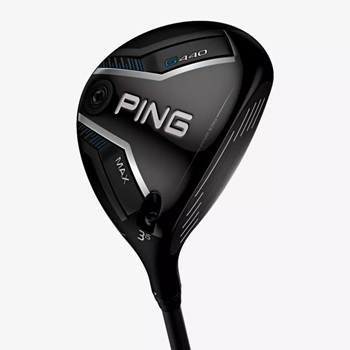Updated June 12, 2025. This article was thoroughly audited by multiple golf experts and coaches for its accuracy. You can read more about our rigorous testing protocol here.
A well-made 3 wood can improve an amateur’s game from the tee box or fairway. Offering a low profile, the best 3-woods on the market provide an excellent combination of power and workability.
Since a 3-wood provides a more compact shape than a driver, some amateurs can experience better dispersion, more fairways hit, and farther distance because of how the club suits their swing.
On our list of the top 3 woods, we’ll take a deeper look at the best available fairway wood for amateurs, their top features, and how they can transform your game.




Featured Recommendations
Last updated on 2025-12-17. The links are affiliate links. Product images are served from Amazon Product Advertising API.
Table of Contents
Best 3 Wood 2025
Ping G440 Max 3-Wood
Best All-Around 3-wood
Check Price on Global Golf
Specifications
- Loft: 15°
- Lie: 58°
- Shaft Length: 43″
- Weight: D2
Pros
- Exceptional forgiveness on off-center strikes
- Improved sound and feel over previous G-series 3-woods
- Effortless launch with extended carry
Cons
- Distance falls slightly short of competitors
- Premium price point
The Ping G440 Max 3-wood stands out as an effectively consistent performer that builds confidence with every swing.
The taller face, when compared to the G430 Fairway, gives tremendous confidence off the tee, while the hosel design redistributes weight to lower the center of gravity for effortless launch.
On the range, we immediately noticed the improved sound and feel compared to previous Ping models.
The deeper, fuller sound at impact provides excellent feedback, and the club feels very stable through impact.
From the short grass of the fairway, the G440 Max excels at maintaining consistent launch even from tighter lies, thanks to the refined sole that sits more flush to the ground.
What impressed us most about the G440 is the Carbonfly Wrap crown. Unlike many carbon fiber crowns that compromise sound, this maintains Ping’s signature feel while redistributing weight for optimal performance.
While the G440 excels in many areas, we found that its distance performance doesn’t quite match that of the longest clubs in its price range.
This becomes more noticeable for high speed swingers who want maximum yardage over accuracy and forgiveness.
For higher handicappers, the G440’s biggest benefit is its incredible forgiveness on off-center strikes.
We found that even toe strikes maintained ball speed and total distance, making it perfect for weekend warriors who don’t always find the sweet spot.
Check our full Ping G440 Max Fairway Wood Review
TaylorMade Qi35 Max 3-Wood
Best 3-wood for Mid Handicappers

Check Price on Amazon
Check Price on PGA Tour Superstore
Check Price on Global Golf
Specifications
- Loft: 15.5°
- Lie: 57°-61°
- Shaft Length: 43.25″
- Weight: D1
Pros
- Maximum forgiveness and easy launch
- Newly adjustable hosel delivers precise customization
- Excellent distance and ball speed
Cons
- Lower profile may not suit all players
- Broader shaped head may not appeal to better players
The Qi35 Max delivers an impressive combination of maximum forgiveness and explosive distance, making it a standout choice for golfers seeking both power and playability.
The larger footprint immediately inspires confidence at address, while the deeper center of gravity makes launching the ball almost effortless from any lie or from the tee box.
During our range testing, we consistently saw high ball flight with impressive carry distances.
The club averaged higher ball speeds than last year’s Qi10 Fairway, delivering exceptional yardage gains to boost our overall distance.
The slight draw bias is perfectly calibrated and noticeable enough to tighten shot dispersion, but not so strong that it creates a hook shot shape for better players.
The standout technology here for us is the adjustable hosel, which was previously fixed on the Qi10 Max model. Having multiple loft and lie combinations allows for precise fitting, resulting in optimal ball flight.
However, the larger head design might not appeal to accomplished players who prefer a more compact, workable setting at address.
Additionally, golfers who naturally draw the ball may find the built-in draw bias works against their preferred ball flight pattern.
The larger head and shallow face design maintains ball speed across the entire hitting surface, encouraging more aggressive swings and ultimately leading to better overall performance for a wider range of amateur golfers.
Check our full TaylorMade Qi35 Fairway Wood Review
Titleist GT2 3-Wood
Best 3-wood for Low Handicappers

Check Price on Amazon
Check Price on PGA Tour Superstore
Check Price on Global Golf
Specifications
- Loft: 15°
- Lie: 56.5°
- Shaft Length: 43″
- Weight: D3
Pros
- Exceptional ball speed gains over previous Titleist Fairways
- Classic Titleist appearance with outstanding modern performance
- Superb feel and responsiveness
Cons
- Premium pricing
- Too demanding for higher handicappers
The GT2 3-wood seamlessly blends tour-level performance with the classic Titleist fairway wood look that players of all handicaps have come to love.
The innovative Proprietary Matrix Polymer crown saves significant weight while maintaining Titleist’s signature sound and feel and lowering CG for higher launch.
On the range, we immediately noticed the increased ball speeds compared to the TSR2 Fairway, averaging notably faster speeds with identical shaft setups.
The flattened sole curvature makes the club sit nicely at address, inspiring confidence for both sweeping and descending strikes.
The seamless crown integration means you get all the benefits of multi-material construction without sacrificing the traditional black gloss finish that Titleist purists demand.
Single-digit handicappers will appreciate the GT2’s perfect balance of performance and workability.
The lower, more forward center of gravity creates a higher launch with lower spin, making it easier to carry hazards and stop the ball on greens.
Despite its impressive performance, the GT2’s higher price point may give budget-conscious golfers pause when comparing it to more affordable 3-woods on the market.
The club’s tour-oriented design philosophy also means it demands more precise ball striking than some game-improvement options.
The Forged L-Cup face provides forgiveness on common 3-wood toe and heel strikes, making it an ideal choice for accomplished players seeking to add versatility to their long game without compromising feel or control.
Beyond some of our complaints, the excellent feedback and performance helped us improve our strike quality as we continued to become comfortable with the 3-wood.
Callaway Elyte 3-Wood
Best 3-wood for Gaining Distance

Check Price on Amazon
Check Price on PGA Tour Superstore
Check Price on Global Golf
Specifications
- Loft: 15°
- Lie: 56°
- Shaft Length: 43.25″
- Weight: D2
Pros
- Revamped Step Sole for improved turf interaction
- Neutral setup allows complete shot shaping and workability
- Exceptional performance on low-face strikes
Cons
- Limited weight adjustability options
- Some may find the sole design lacks
The Elyte 3-wood showcases what uncomplicated golf club design can do for casual golfers.
This exciting 3-wood addresses the most common challenges golfers face with long clubs, particularly turf interaction and consistent ball striking in a fun, inexpensive package.
During our time testing this muscular 3-wood, we consistently achieved impressive ball speeds, with exceptional performance on low-face strikes.
The club launches effortlessly high while maintaining optimal spin rates, creating that high ball flight that amateur golfers crave.
The game-changing innovation lies in the neutral flight characteristics combined with the Step Sole technology.
The innovative Step Sole design delivers significantly smoother turf interaction, creating cleaner contact from various lies compared to other 3-woods on the market.
One potential drawback is the unique color design, especially on the sole, which some traditionalists might find visually distracting or unconventional when at address.
The club’s focus on innovation over weight adjustability also means fewer customization options compared to competitors that utilize hosel and weight adjustability.
Weekend warriors will discover that the Elyte addresses two of their biggest fears with the 3-wood: hitting it fat and not getting enough height.
The new sole virtually eliminates chunky strikes by reducing the sole’s contact area with the turf, while the low and forward center of gravity creates launch conditions that make reaching distant greens much more achievable.
Check our full Callaway Elyte Fairway Wood Review
TourEdge HL-X525 3-Wood
Best 3-wood for Beginners

Check Price on Amazon
Check Price on PGA Tour Superstore
Specifications
- Loft: 16°
- Lie: 58°
- Shaft Length: 43.5″
- Weight: D1
Pros
- Exceptional value at its price point
- Extreme slice-fighting capabilities
- Houdini Sole technology for improved turf interaction
Cons
- Strong draw bias won’t suit all players
- Fixed hosel limits customization
The HL-X525 3-wood offers an exceptional value proposition that delivers premium performance at a budget-friendly price point.
This game-improvement 3-wood delivers draw-bias performance that rivals clubs costing twice as much, making it an outstanding option for budget-conscious beginners who still want distance and consistency for less money.
The X525’s offset design and heel weighting immediately showed its slice-fighting capabilities on the range. We consistently saw draw-biased ball flights that would benefit golfers struggling with left-to-right misses.
The shallow face and high MOI design create effortless launch, even for moderate swing speeds, while the Ridgeback Technology provides surprising stability at impact by stabilizing the club head.
The patented Houdini Sole system positions the center of gravity incredibly low and back.
This unique sole design not only improves launch conditions but also helps the club glide through various lies with minimal turf resistance.
Keep in mind that the pronounced draw bias might actually hurt golfers who already struggle with hooks or pull shots.
The fixed hosel design also limits options for players who might benefit from loft and lie hosel adjustments to optimize their ball flight.
Golfers battling slices and low ball flight will find the X525 more than helpful to their game. The offset helps square the face at impact, while the ultra-shallow face profile makes contact feel clean and easy.
Cobra DS-Adapt X 3-Wood
Best 3-wood for Workability

Check Price on Amazon
Check Price on PGA Tour Superstore
Check Price on Global Golf
Specifications
- Loft: 14.5°
- Lie: 56°-60°
- Shaft Length: 43.25″
- Weight: D2
Pros
- Revolutionary 33-setting adjustability system
- SMARTPAD technology maintains a square face angle
- Excellent balance of forgiveness and workability
Cons
- Lacks color contrast at address
- Complex adjustment system may overwhelm some players
The DS-Adapt X 3-wood represents a breakthrough in customizable golf technology with its revolutionary FutureFit33 system that transforms the customization experience.
Having numerous unique loft and lie combinations available allows precise optimization for individual swing characteristics that we’ve never seen before in 3-woods.
During range testing, the mid-forward PWR-Bridge weighting delivered exactly the performance promised with reduced spin and maintained launch.
The slightly shallower face design compared to the LS model makes it accessible to a wider range of players while still providing excellent workability.
What truly sets this club apart is the innovative SMARTPAD technology that keeps the face square regardless of the hosel setting.
This means you can dial in perfect ball flight characteristics without worrying about alignment issues, representing a game-changing advancement in adjustable technology.
Some golfers might find the 33 adjustment options overwhelming, especially those who prefer simpler, grab-and-go equipment.
The visible QR code etched onto the hosel also detracts from the club’s otherwise sleek aesthetic appeal.
But these numerous settings allow for fine-tuning that can transform ball flight from low and spinning to high and penetrating.
Most golfers can find multiple settings that dramatically improve their performance with a little extra time tweaking the club on the range.
This level of customization means the club can evolve with your game over time, making it a worthwhile investment, no matter your handicap, rather than just another short-term equipment purchase.
Srixon ZX MK II Fairway Wood
Best Distance 3-Wood for High Handicappers

Check Price on Amazon
Check Price on PGA Tour Superstore
Check Price on Global Golf
Specifications
- Loft: 13.5°-21°
- Lie: 57°-58°
- Length: 42”-43”
- Weight: D2, D3
Pros
- Fixed hosel offers reliable shotmaking
- Powerful launch provides exceptional distance
- Flexible face transfers maximum power to the golf ball
Cons
- Lacks adjustable features, not ideal for lower handicap players
Srixon, long making top-notch fairway woods, has another impressive release with their ZX MK II 3-wood.
Available in either a 13.5 or 15 degrees option, the fairway wood offers dependable performance that hits the ball high, long, and straight.
Along with its low profile, the Srixon wood delivers a nice feel at impact, helping build your confidence on the course.
The face also offers mid-tier forgiveness, especially on toe strikes, something mid and high handicappers can benefit from on long par 5s.
While we prefer woods that offer adjustable features, we couldn’t help but enjoy the smooth performance of the ZX MK II.
Especially when your ball sits in the fairway, the rounded sole glides over the turf without snagging to provide a clean strike.
The Srixon ZX MK II delivers outstanding all-around performance if you are looking for a dependable option for your secondary woods.
How We Tested the Fairway Woods
In testing the 3 woods for this buying guide, we adhere to a precise methodology to ensure accuracy and reliability in our recommendations.
Our testing process prioritizes key performance metrics that matter most to golfers.
Distance, accuracy, forgiveness, and feel serve as the foundations of our evaluation criteria.
We thoroughly measure the distance potential of each 3 wood, considering both carry and total distance to provide a comprehensive overview of its capabilities.
Accuracy is assessed through repeated shots, examining dispersion patterns to gauge the club’s consistency and precision.
Forgiveness is another critical aspect we scrutinize, evaluating how well each 3 wood handles off-center strikes and mitigates the effects of mis-hits.
Finally, we delve into the subjective aspect of feel, considering factors such as sound, feedback, and overall sensation at impact.
Our testing team comprises experienced golfers with a deep understanding of the game and its equipment, ensuring that our assessments are rooted in real-world performance.
By adhering to this thorough testing process, we aim to equip our readers with the knowledge they need to make informed decisions when selecting a 3 wood for their golf bag.
How to Choose the Best 3 Woods
Loft
The 3-wood typically features a 15-degree loft. While the loft is undoubtedly lower than a driver, the additional loft provides a higher launch when compared to a #1 wood. Of course, that comes at the cost of distance.
While a 3-wood certainly gets the ball down the fairway, a driver hits the ball roughly 15 to 30 yards further when measuring full-strength swings.
With an adjustable loft sleeve, golfers can raise or lower the loft of the face to achieve a lower shot height and greater distance, or a higher arc with shorter results.
The customization of the loft and offset also increases workability for shot-shaping from side to side.
Looks
The appearance of a 3-wood can instill confidence in a golfer. With a strong look, a first-rate fairway wood can back up its exceptional appearance with high performance.
Modern fairway woods feature a sleek, sharp design that offers a cutting-edge look. The rounded crown of the head offers a shiny or matte finish that can either dazzle or attract playing partners with questions of curiosity.
While most fairway woods have a busy sole with a chaotic look, the chaos comes with a purpose. If the sole feature is stationary weighting, the chrome can stand out against the backdrop of the primary design.
Adjustability
Most 3-woods do not have adjustable features. The fixed hosel and lack of movable weighting provide a more stable appearance and consistent performance.
On the 3-woods that do offer adjustability, golfers can expect to find a loft sleeve that increases or decreases lie angle and potentially adds slight offset. For advanced players, the loft sleeve offers ultimate customization.
Sole weighting is another feature that occasionally appears on a new, name-brand 3-wood. The weighting allows you to set the club up to hit a fade or draw with more ease.
While there are advantages to customization, most amateurs are best served by fixed features.
Forgiveness
Most 3-woods have a smaller head than a hybrid. The compact head shape allows for maximum swing speed, increasing distance, while the elongated face provides ample impact area.
Modern 3-woods utilize the latest innovations to increase forgiveness when the ball comes into contact off-center on the face. Even on impact away from the sweet spot, the 3-woods of today do an excellent job of keeping the ball along the target line.
The compact head does provide better stability, similar to a hybrid, to reduce twisting and the dreaded side spin that causes slicing and hook shots.
Versatility
The 3-wood can be used in various areas on the course. The most obvious use is from the fairway on longer par 5s. Since most golfers face a second shot of over 250 yards, the 3-wood can provide the distance with better accuracy.
Other golfers love hitting their 3-wood off the tee box. On tighter par 4s with a narrow fairway, the 3-wood offers distance benefits along with tighter shot dispersion.
Finally, the 3-wood can actually be used in the short game. In deeper rough off the green, the 3-wood can smoothly move through the grass without twisting for clean contact.
Budget
Most new 3-woods are pretty expensive, comparable to the cost of a new driver. While the 3-wood is cheaper, a well-made fairway wood will certainly come at a significant price.
The most expensive 3-wood options typically feature additional features, such as a high-grade shaft, adjustable loft sleeve, and weighting.
Value 3-woods are available at a significantly lower price, comparable to the cost of premium wedges. While their performance might not reach the heights of a name-brand version, the value fairway woods certainly hold their own.
As with any club purchase, the cost of a fairway wood should be factored into a budget, considering the entire club set.
Frequently Asked Questions

What is the most used 3 wood on the PGA Tour?
The TaylorMade Qi35 3-wood is currently the most popular 3-wood model among top PGA Tour players. Prominent golfers like Scottie Scheffler and Rory McIlroy carry the 3-wood to win majors.
The Qi35 fairway wood line offers a balance of distance and forgiveness. Specifically, the Qi35 Tour is a titanium model featuring adjustable settings for control and lower spin, making it appealing to golfers with faster swing speeds.

How far should the average golfer hit a 3 wood?
On average, a male golfer might expect to hit a 3-wood somewhere in the neighborhood of 190 to 220 yards.
Keep in mind, though, that this can change quite a bit depending on your swing, how well you connect with the ball, and even the type of golf ball and club you’re using.
The weather and the course itself can also affect how far the ball travels.

Who makes the easiest to hit fairway Woods?
If you’re looking for a fairway wood that’s easy to hit, many golfers have good experiences with brands like Tour Edge, Cobra, and TaylorMade.
These companies often design their clubs with features that make them more forgiving, such as larger clubheads and technology that helps the ball get up in the air more easily, even if you don’t hit it perfectly.

Should I replace my 3 wood with a hybrid?
Many golfers find that swapping out their 3-wood for a hybrid can be a smart move, especially if they’re looking for more consistent shots.
The best hybrids tend to launch the ball higher and are often more forgiving than a 3-wood, which can be really helpful when you’re not hitting from a perfect lie.


